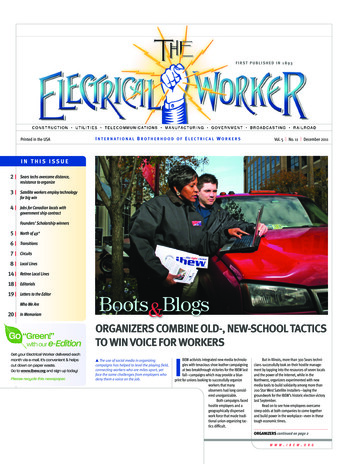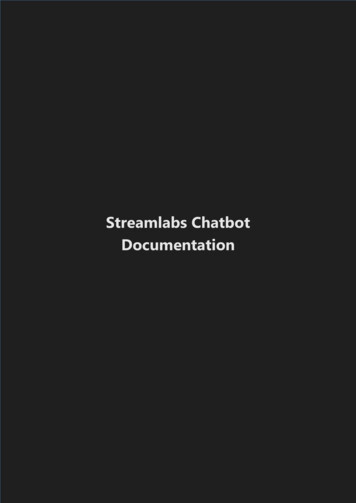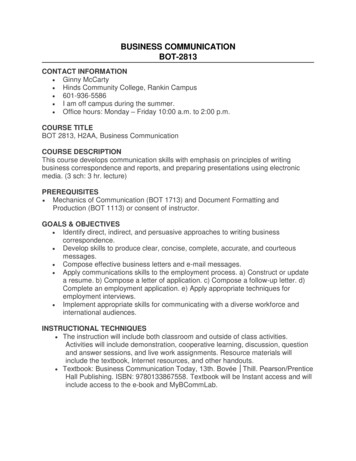
Transcription
FIRST PUBLISHED IN 1893Printed in the USAINTERNATIONAL BROTHERHOOD OF ELECTRICAL WORKERSVol. 5 No. 11 December 2011IN THIS ISSUE2 Sears techs overcome distance,resistance to organize3 Satellite workers employ technologyfor big win4 Jobs for Canadian locals withgovernment ship contractFounders’ Scholarship winners5 North of 49 6 Transitions7 Circuits8 Local Lines14 Retiree Local Lines18 Editorials19 Letters to the EditorWho We Are20 In MemoriamGo “Green!”with our e-EditionGet your Electrical Worker delivered eachmonth via e-mail. It’s convenient & helpscut down on paper waste.Go to www.ibew.org and sign up today!Please recycle this newspaper.Boots&BlogsORGANIZERS COMBINE OLD-, NEW-SCHOOL TACTICSTO WIN VOICE FOR WORKERS The use of social media in organizingcampaigns has helped to level the playing field,connecting workers who are miles apart, yetface the same challenges from employers whodeny them a voice on the job.BEW activists integrated new media technologies with tenacious shoe-leather campaigningat two breakthrough victories for the IBEW lastfall—campaigns which may provide a blueprint for unions looking to successfully organizeworkers that manyobservers had long considered unorganizable.Both campaigns facedhostile employers and ageographically dispersedwork force that made traditional union organizing tactics difficult.IBut in Illinois, more than 300 Sears technicians successfully took on their hostile management by tapping into the resources of seven localsand the power of the Internet, while in theNorthwest, organizers experimented with newmedia tools to build solidarity among more than200 Star West Satellite installers—laying thegroundwork for the IBEW’s historic election victorylast September.Read on to see how employees overcamesteep odds at both companies to come togetherand build power in the workplace—even in thesetough economic times.ORGANIZERS continued on page 2W W W . I B E W . O R G
2The Electrical Worker December 2011Boots&Blogs Organizers Combine Old-, New-School Tactics to Win Voice for WorkersContinued from page 1Ill. Sears Service Techs Win Innovative Organizing Campaignic Carusi knew what he had todo. For 17 years, he had servicedlawn and exercise equipment forSears in northeast Illinois. But a newdistrict manager was making life miserable for him and more than 300 othertechnicians who work primarily in thestate’s northeast.Technicians always expected somejobs to run into overtime, but the manager’s lack of respect for basic familyneeds had reached a breaking point.Like when a technician, Lou Ervin, withmore than 20 years of seniority asked fortime off to attend his daughter’s collegegraduation, and was told, “Sure, turn inyour keys, take all the time you want.”“My father told me growing up, ‘Don’tlet anyone step on you,’” says Carusi.So, in October 2010, Carusi talkedto a couple of players on his softballteam who are members of Local 176 inJoliet. Carusi, who knew that Sears technicians in Colorado and Wyoming wererepresented by Denver Local 68, told theelectricians that conditions might beripe for his co-workers to follow suit.Joliet members advised Carusi totalk to the Local 176 Organizer MattVSixth District Organizing Coordinator Jeff Radjewski, left, and Chicago Local 134Organizer Abe Rodriguez discuss upcoming first contract negotiationscovering newly organized Sears service technicians.Kenney, who contacted the MembershipDevelopment Department.Eleven months later, an innovativeorganizing campaign that combined theefforts of seven locals representing multiple IBEW branches reached the finishline as technicians voted 184 to 125 infavor of representation by Chicago LocalSears Repairmen: A Proud History of Servicehe customer-based work ethicthat is personified by today’srepairmen has served Sears wellfor generations.An advertisement in a 1962 issueof Life Magazine shows a line of Searsservice trucks, emblazoned with the slogan, “We Service What We Sell.”Opposite the trucks, immaculately uniformed appliance repairmen race to taketheir places behind the steering wheel.In the consumer-driven postwareconomy, the Sears serviceman was thetrustworthy guy you called when thewashing machine stopped wringing orPierre Powell, a 32-year Searsthe refrigerator turned warm. Work wasemployee, says, ‘I want to help thesteady and pay and benefits at the com- younger workers correct injustice onpany, whose catalogue was known asthe job.’the “consumer’s bible,” were sufficientto put repair technicians solidly in the middle class.That was then. The tables turned on the iconic retailer. Sears, the subject of noless than six books on its history and finances listed on Amazon.com, was purchased by a bankrupt K-Mart in 2004.The new company, now directed by hedge fund financiers, is struggling andcould go under as Walmart, Best Buy and other competitors turn up the heat andseize more retail market share.For service technicians, says Pierre Powell, a 32-year Sears employee whorepairs cooking equipment, the competition means that everything became numbers-driven. “It’s hard for the younger guys because they don’t get enough trainingon new products and need to learn them on their own,” he says. T134. It was the largest win in the SixthDistrict in many years and a critical onein the IBEW’s efforts to organize Searsworkers across North America.Dirty TricksSixth District International OrganizingCoordinator Jeff Radjewski says Searswas relentless, employing carrot andstick tactics to oppose the campaign.The company held captive audiencemeetings. They tried to sidetrack organizers by removing some poor managers,reducing overtime requirements andhanding out gift certificates.Simultaneously, however, Searsplayed hardball, giving the union an inaccurate worker contact list, spreading misinformation about the IBEW and trying toconfuse workers on voting locations.Despite the company’s efforts, astrong, well-respected volunteer organizing committee came together, preparingtheir co-workers for the company’s tactics and setting up a Web site for them toshare comments and information.Internet LevelsPlaying FieldPierre Powell, a Chicago-area repairmanwith 32 years at Sears, had participated inpast unsuccessful organizing campaigns.He followed organizing activities by otherSears technicians by visiting a Yahooonline group set up about 10 years ago.“The Internet leveled the playingfield,” says Powell, adding that Searshad combined two districts in Illinois“with the mentality that the geographical spread would be enough to calmdown the union talk.“Sears told technicians ‘the unionwas going after us,’” says Powell. Butworkers knew the truth—that technicians had sought out the union. Thetechs and the IBEW became partnersafter that, says Powell.Before the campaign, Sears had“targeted some technicians because oftheir outspokenness,” says Powell, whorepairs cooking appliances. The customersloved them, but they were fired anyway.“That was a game changer,” he says.“I can’t be anything but hopeful,”says Powell. “I’m 51 years old and haveeight or nine years to go. I want to helpthe [younger workers] correct injusticeon the job.”In October, a new manager pulledPowell aside and asked if he would beinterested in taking a management position. Powell turned him down.“I like dealing with the customersone-on-one,” says Powell, whoexpresses hope that an improved relationship between managers and workerswill improve customer service, job security and the company’s bottom line.Organizing Spirit SpreadsAcross ContinentIBEW’s Sears campaign is picking up astechnicians challenge managers whoabuse their authority and mistreattheir employees.In February, Halifax, Nova Scotia,Local 1928 signed its first collective bargaining agreement covering Sears service technicians. The template for theagreement was a prior one betweenSears and Vancouver, B.C., Local 213.Local 134 Organizer Abe Rodriguezsays the Illinois campaign “blended oldand new technologies.” Postcards weresent out to prospective members, butthe Web site, www.unitedtechsgreatlakes.webs.com was there for youngertechs who “live off their laptops andcell phones.”Assisted by Region 3 LeadOrganizers Mike Green and SteveFosness, the volunteer organizing committee, says Rodriguez, “did a fantasticjob.” Illinois locals contributing to thecampaign’s success included: ChicagoLocal 9, Elgin Local 117, Chicago Local134, Waukegon Local 150, Aurora Local461 and Lisle Local 701. Also participating was Louisville, Ky., Local 369.As a symbol of the volunteers’commitment, Rodriguez remembers anorganizing meeting that was called during a snowstorm when techs mighthave preferred to stay home to watch abig football game between the ChicagoBears and the Green Bay Packers. Fiftytechnicians showed up.Rodriguez, who is bilingual,reached out to Hispanic workers, part ofa diverse group that included Arabicspeaking Americans, African-Americansand women.Synergy Helps Engage21st Century Work ForceSays Radjewski, “The Illinois techniciansreflect the 21st century work force. This isa classic example of how severalbranches of the Brotherhood can worktogether and create a synergy thatwouldn’t exist otherwise.”Radjewski and Lou Ervin, the technician who was threatened for attendinghis daughter’s graduation, described theSears campaign at the MembershipDevelopment Conference last month.During the campaign, the managerwhose actions helped instigate thedrive visited Carusi at home and thenaccompanied him on his route, trying todiscourage his participation in the campaign. The manager was removed by thecompany. “I told him I’d been there 17years and I would outlast him,” Carusisays. “And I did.”Hoping for a DecentFirst ContractCarusi is looking to improve some benefits in a first contract with Sears. He sawhis defined benefit pension plan frozenabout 11 years ago. Married with twochildren, Carusi, 37, pays 600 a monthout-of-pocket for health insurance.He doesn’t know how negotiations will turn out, but he knows IBEWhas his back.“I went to Matt Kenney and toldhim I wanted to start a union drive covering hundreds of miles and 344 people.He took time away from his family formonths [to help us organize].”“I told him, ‘You have little kids,you can step down now,’ but MattKenney stayed with us,” says Carusi.“That’s the kind of people that make theIBEW a great union.” VideoGO FURTHER INSIDE THIS MONTH’SCOVER STORY: Check out video highlighting Sears techs’ organizing victory atwww.YouTube.com/TheElectricalWorker.
The Electrical Worker December 20113Boots&BlogsOnline Savvy, Shoe Leather Organizing Win Satellite Workersatellite installation technicians inthe Northwest won a big victorySept. 14, voting to join the IBEWafter a tough two-year organizing campaign at Star West Satellite—a companyinfamous for its anti-union managementand often brutal working conditions.Fusing sophisticated 21st centurymedia technologies with tactics as old asthe labor movement itself, organizers saythe strategy employed at Star WestSatellite may provide a blueprint for otherunions looking to successfully organize intoday’s hostile anti-labor climate.SBreaking PointStar West’s satellite technicians installand maintain satellite dishes for DishNetwork, bringing CNN, HBO,Nickelodeon and hundreds of otherchannels to communities across Idaho,Montana and eastern Washington State.Hispanic workers were in themajority at many of Star West’s 12 shopsin the tri-state region. One of thoseHispanic workers was Mario Diaz, aseven-year employee.Diaz, who lives just outside Boise,Idaho, said that despite the low pay andminimal benefits, he was happy with hisposition as a trainer for new employeesand planned to make a career at the company. But everything changed after heended up on the receiving end of management’s arbitrary disciplinary policy.Diaz was installing a satellite twoyears ago, when the customer asked ifhe could do some more customizedwork around the house—a violation ofcompany policy. Diaz politely refused.“The guy called my supervisor tocomplain about me,” he said. “My bosslooked at the situation and told me that Idid everything I was supposed to do, buthe was still suspending me without pay—all for following company rules.”For Diaz, it was the final straw.“Everyone was afraid of being fired orhaving their good routes taken away;they didn’t want to speak out or do anything,” he said. “I was finally at the pointwhere I said, ‘If they want to fire me, goahead, but I wasn’t going to take it anymore.’” And he wasn’t the only one.The Low-Road ModelWith unemployment running near 10 percent, Star West should be able to command a stable and loyal work force. Butthe company’s model of workplace relations—with its low pay, minimal benefitsand draconian work rules—has driven theUnionizing Star West would requirea long-term commitment to patientlybuild ties with workers spread out acrosstens of thousands of miles—long beforean NLRB-election was even a possibility.So Kniffin and Brock came up withthe idea for Satellite Techs Allied for aNew Direction, a largely online groupthat gave nonunion satellite workers theopportunity to connect with the IBEWand each other. But most importantly, itlet techs get active in bettering theirworkplace and building solidarity.Launched in 2009with the strong support ofEighth DistrictInternational ViceStar West SatellitePresident Ted Jensen, theemployees—whoSTAND Web site—install satellitewww.satellitetechs.org—dishes for Dishquickly became a hub ofNetwork—endureddiscussion for satellitelong hours,minimal pay andtechs across the country.abusive“The STAND Webmanagement.site was moderated tokeep management spiesCredit: Photo used under aCreative Commons Licenseoff,” Brock said. “It basifrom Flickr user Commoraney.cally acted as their unionThe Satellite Techs Allied for a New Direction Web site proved to behall, serving as a clearingemployee turnovera key organizing tool at Star West.housefor resources andrate to more than 80communication.”told Diaz, still laid ahead. “We realized thatpercent in the last two years.While relying on social media,even if we successfully organized one locaCovering a 200,000-square-mileBrocksays that much of the inspirationservice area, technicians could be on the tion, there were 11 others in the chain andforSTANDcomes from the early organizthe company could play them against eachroad for up to 18 hours at a time, saysing experience of the IBEW.other to make sure we never got a conIBEW organizer Bob Brock. Denied over“You have to remember that thetract,” he said. “The campaign had to betime pay, workers were often docked forIBEWexistedfor more than 30 yearsthe drive time from job to job. Many were company-wide or it just wouldn’t work.”beforecollectivebargaining was evenlabeled independent contractors, a deslegalintheeyesofthe federal governignation that put basic protections underment,”hesaid.“Weneed to get workersOrganizingChallengesstate and federal labor law out of reach.interestedintheunionconnected andHealth and retirement benefits areThe campaign to organize Star Westinvolvedrightaway,evenif we don’t thinkalmost nonexistent. Workers are requiredstarted in 2006 after employees conan election is on the immediate horizon.”to have multiple years of service beforetacted Billings, Mont., Local 532. Thethe company would contribute to theirIBEW launched a national effort that year401(k) accounts. And for some employto organize the largely nonunion satellite Winning the Voteees, health insurance bills went unpaid,industry. “Those contacts soon left thedespite regular premium deductions fromBy the fall of 2010, organizers hadcompany, but it got me thinking abouttheir paychecks, leaving them to find outenough cards to file for an election—thelearning from the challenges we’d seenonly in the doctor’s office or emergencyfirst company-wide petition ever filed atelsewhere,” Brock said.room that the insurance they and theirThe union made some inroads, par- a multi-state satellite company. But thefamilies were counting on was not there.challenges in campaigning were twoticularly at MasTec locations in GeorgiaDiaz pulled out a business cardfold: the aforementioned high turnoverand Florida (see “MasTec Satellitefrom IBEW organizer Willy Kniffin, who,rate and the huge geographical spreadTechnicians Install IBEW in Georgia,” thealong with fellow organizer Brock, wasof the service area, which made it diffiElectrical Worker, June 2009) but hostileheading up an effort to organize thecult to contact employees in person.employers and weak labor law enforcesatellite industry in the region. Diaz firstAfter one particularly frustratingment made those victories the exceptionmet Kniffin through a chance encounterdayofdoor-knocking, Kniffin got anrather than the rule, says Brock.months before while he was fueling upidea,rememberingthe personal digital“I looked at the record of NLRB vichis truck en route to a job.camcorderhehadstoredin his trunk.tories in the satellite industry going backThe next evening Diaz met with theHe and Brock put together a quickto its beginning and it didn’t give us a lotorganizers, and within a few days, nearlyvideo talking about the IBEW andof hope,” he said. “The law wasn’t oneveryone at the 40-person shop hadburned it to dozens of DVDs, leavingour side so it forced us to try to get cresigned cards.them on employees’ front steps.ative about how we wanted to move forBut the biggest challenge, KniffinKniffin says that the DVDs gaveward with the campaign.”employees a more personal connectionwith the campaign than they could witha flier, leading to increased traffic on theSTAND Web site, where workers couldwatch more videos, including a primeron labor law.The company tried to keep theunion at bay by threatening shutdownswhile promising a big wage increase if theworkers voted against the IBEW.“We posted Star West’s promiseson the Web site, which forced management to put their money where theirmouth is,” Brock said.Organizers also were able to settlemore than two dozen unfair labor practice charges against the company withthe NLRB, including winning more than 10,000 in back wages for four discharged workers.“That is when the momentumstarting really going in our favor,” Brocksaid. “STAND was able to win positiveworkplace changes even before the election, getting buy-in from employees. Itmade clear the importance of real collective bargaining.”Last spring, Diaz was offered a better paying job at an oil field, but heagreed to work with Brock and Kniffen asa temporary organizer until the election.As important as the Web was in buildingthe campaign, they still needed face-toface organizing to seal the deal.“Mario was vital because he was aformer Star West employee,” Kniffin said.Workers voted by a 78-65 margin tojoin the union in September.Back to BasicsThe main lesson learned, says Brock, isthat unions can’t wait for the NLRB to getinvolved before they start organizing.“It is about getting back to thebasics of organizing,” Brock said. “It ishow the IBEW organized the utility andtelecommunications industry in the early20th century, winning members and fighting for positive change in the workplacebefore a contract was even a possibility.”Delegates at the 38th InternationalConvention unanimously passed a resolution calling on the International Officeto examine the possibilities of creatingan organization of associate memberswho would have a chance to learn aboutthe IBEW and build ties with it.“It took us two years to even get toa vote at Star West, but that didn’t stopus from signing up supporters and fighting to make improvements in the workplace,” Brock said. “You don’t needanyone’s permission to organize.” W W W . I B E W . O R G
4The Electrical Worker December 2011From Coast to Coast, Canadian ShipbuildingContracts Mean IBEW Jobshe shipbuilding industry onCanada’s Atlantic and Pacificcoasts got a big boost from thefederal government Oct. 19 withthe announcement of two multi-billiondollar shipbuilding contracts that willcreate thousands of new maritime andconstruction jobs in British Columbiaand Nova Scotia.T“We’re talking almost 20 million in electricalwork alone, whichtranslates into a lot ofman-hours.”– Cordell Cole, First DistrictInternational Representative“This is huge news for all shipyardworkers and its effects will be feltthroughout British Columbia,” saidVancouver Local 213 Business ManagerMike Flynn. Vancouver Shipyards Co.Ltd., won an 8 billion contract to buildseven non-combat ships for the RoyalCanadian Navy and Coast Guard, whichis expected to create more than 4,000jobs, including hundreds of Local 213maritime positions.The Canadian government committed to revamping its largely outdatedfederal fleet more than a year ago, setting up a task force to develop a longterm strategy to help revitalize thecountry’s shipbuilding industry. Federalplanners say they wanted to avoid thetraditional boom-and-bust cycle thathas plagued the industry in the past bycreating a steady supply of shipbuildingwork spread out over a number of years.The newest projects are expected to takeupwards of two decades to complete.Getting Vancouver Shipyards readyfor the job will require more than 200 million in infrastructure work, which meansgood jobs for inside wiremen as well.“The news is really exciting for ourmembership,” said Local 213 AssistantBusiness Manager John Pesa. “I’m getting calls from people who want to jointhe IBEW just to work on this project.”On the East Coast, Halifax’s IrvingShipbuilding Inc. won a 25 billioncontract to build 21 combat-readyships for the navy, bringing thousandsof jobs to a province suffering fromhigh unemployment.Nova Scotia Premier Darrell Dextertold the Canadian Broadcasting Corp. thatNova Scotians who have left the provinceand are now in Alberta or other parts ofthe country can bring their skills home.Irving Shipbuilding workers arerepresented by the Canadian AutoWorkers, but the building trades—including the IBEW—will do the morethan 100 million in preparatory infrastructure work.“We’re talking almost 20 million inelectrical work alone, which translatesinto a lot of man-hours,” says First DistrictInternational Representative Cordell Cole,who services inside locals throughoutNova Scotia and New Brunswick.“I think we are looking at the endof outsourcing in the Canadian shipbuilding industry,” says Flynn. “By modernizing the Halifax and Vancouvershipyards, the military orders will helpboost the civilian shipbuilding industryas well.” Local colleges are already beefing up their offerings in the maritimetrades to meet the expected demand forhighly skilled shipyard workers.Work is expected to begin on theships sometime in the next two to fouryears. Vancouver Shipyards Co. Ltd., is therecipient of an 8 billion contract tobuild seven non-combat ships for theRoyal Canadian Navy.Photo used under a Creative Commons License from Flickr user keepitsurreal2011 Founders’ Scholarship WinnersTake Training, Advocacy to Next Levelwo IBEW members exemplifying the high standards of trade unionism are recipients of thisyear’s Founders’ Scholarship awards. BrothersJonathon Dehmel and Richard Cesta say they areexcited and grateful for the chance to boost their educationto benefit their locals and the movement.The scholarship fund was established in 1966 byInternational President Gordon Freeman to help IBEW members obtain higher education degrees.Richard CestaDehmel serves as the assistant business manager forTampa, Fla., Local 915. He is pursuing a master’s degree in public administrationfrom the University of South Florida—a goal that he says will help in his role coordinating membership development for the local.“In the trade, you’ve got a given set of tools to get the job done. In a leadershipsense, I want to expand my toolkit,” he said. The third-generation IBEW journeymanwireman said his program is like a nonprofit equivalent of an MBA degree, allowinghim to study budgeting, strategic planning, performance measures, law and variousmanagement techniques.“Everybody has good ideas about how to grow the union,” he said, “but beingable to effectively implement those ideas is where the rubber meets the road.Getting the chance to put this schooling to use is what will, I hope, help turn goodideas into reality.”Advancing the movement is priority No. 1, he says, after a tumultuous year thathas seen increasing right-wing hostility to the middle class. Dehmel has worked onthe Pinellas County Democratic Executive Committee and has been active in “Awakethe State” political events in Florida, partnering with pro-working family organizations to stop Gov. Rick Scott’s opposition to workers’ rights.“‘Awake the State’ is a good way to be out there for the union movement to support the middle class,” he said. “It’s reminded people of the benefits of labor andwhat we can accomplish by working together.”TDehmel and his wife, Jamey—both studentsand full-time employees—are expecting their firstchild later this month.Cesta, a journeyman wireman out ofSteubenville, Ohio, Local 246, teaches two nights aweek at his area JATC and works full-time for BrownElectric. In addition to heavy workloads anddemanding schedules, the father of three is pursuJonathon Dehmel and wife,ing an online master’s degree in work force developJameyment and education from the University of Arkansas.“I want to keep improving what I do, becoming as effective as I can be for myselfand for my students,” Cesta said. He holds a bachelor’s degree in organizationalleadership and development from Wheeling Jesuit University and has an instructordiploma from the National Training Institute.After five years as an apprentice instructor, Cesta continues to complete trainthe-trainer courses and has earned numerous industry-related certifications. A project he completed while earning his bachelor’s gave Cesta the skills to create a newinstrumentation program at the JATC.“The most rewarding aspect of being an instructor is making a difference inapprentices’ lives and in my organization,” he said. “I encourage students to staypositive and to be persistent with regards to gaining the knowledge and skills necessary for individual and organizational success. I also urge them to treat setbacks asopportunities by learning something of value in every situation.“I was thrilled to get this scholarship and appreciate what it will mean for myprofessional development, my students and my family,” he said.Cesta is a veteran of the U.S. Marine Corps. His father was a member of theUnited Steelworkers.As Founders’ Scholarship recipients, Cesta and Dehmel have each earned 200per semester hour toward their degrees with a maximum amount of 24,000, not toexceed an eight-year period.
The Electrical Worker December 20115North of 49 Au nord du 49 parallèleNew Training Program Sets Standard forCanadian Solar Industryn IBEW partnership launchedthe first ever Canada-widepersonnel certification forqualified electricians in solarphotovoltaic installation and maintenance during the events preceding the38th IBEW International Convention inVancouver, British Columbia.Developed by the NationalElectrical Trade Council—a partnershipbetween the IBEW First District and theCanadian Electrical ContractorsAssociation—the new program will helpstandardize solar training curriculaacross Canada, bringing together theexisting patchwork of local training programs into one national course.First District Vice President PhilFlemming awarded the first PV certifications to six Vancouver Local 213 members, including Dustin Thomas, who isemployed by signatory contractor UnitedPower Ltd.“The IBEW was in danger of beingleft behind in the renewable field unlesswe jumped on something like this,”Thomas said at the Sept. 16 event.A qualified work force for solar PVinstallation is critical to capturing workin this emerging market, Flemming said.“A national set of articulated standardsand training benchmarks is needed asthe industry grows.”The program was jointly developedwith CSA Standards, Canada’s leadingdeveloper of national safety and workplace regulations.“We can all be singing the samesong and working from the same text,”says Windsor, Ontario, Local 773Business Manager Sol Furer. “It alsomeans locals don’t have to waste timetrying to put together their own curriculum when solar comes to their area.”Furer also represents the Eighth Districton the International Executive Council.Windsor has been a major centerfor solar growth in the last couple ofyears, particularly since green energylegislation made Ontario the leader inCanada’s photovoltaic industry.“The buzz in Ontario is photovoltaics and we’re right in the middle ofit,” Furer says. More than 120 Local 773members went to work this summerinstalling solar panels for a new 10megawatt solar farm.The local has also been busyinstalling panels on public buildings,like the Tecumseh Arena and a newWindsor elementary school.“It’s a huge area of growth for us,”Furer says.AAll Red Seal-certified electricianswho have completed a recognized photovoltaic training program are eligible tobe certified through a CSA Standards’proctored examination. The Red Seal isthe national certification of excellence ina particular craft.“This work needs to be done byqualified electricians,” said Thomas.“With solar, we’re talking live power, andyou don’t want someone doing this workwho isn’t fully qualified and experienced.”The program will be marketed byCSA Standards across Canada to apprenticeship programs, universities and localgovernments to encourage the growth ofa trained solar work force.“We see this as being the go-tocurriculum for all solar trainers acrossCanada,” Flemming said. First District VicePresident PhilFlemmingpresents PVcertification toVancouver Local213 memberMartin Kugler.Le Viceprésident duPremier DistrictPhil Flemming, àdroite, présenteà Martin Kugler,membre de laS.L. 213, lacertificationdans le domainephotovoltaïque.Un nouveau programme de formationétab
The company held captive audience meetings. They tried to sidetrack organ - izers by removing some poor managers, reducing overtime requirements and handing out gift certificates. Simultaneously, however, Sears played hardball, giving the union an inac - curate worker contact list, spreading mis - information about the IBEW and trying to











